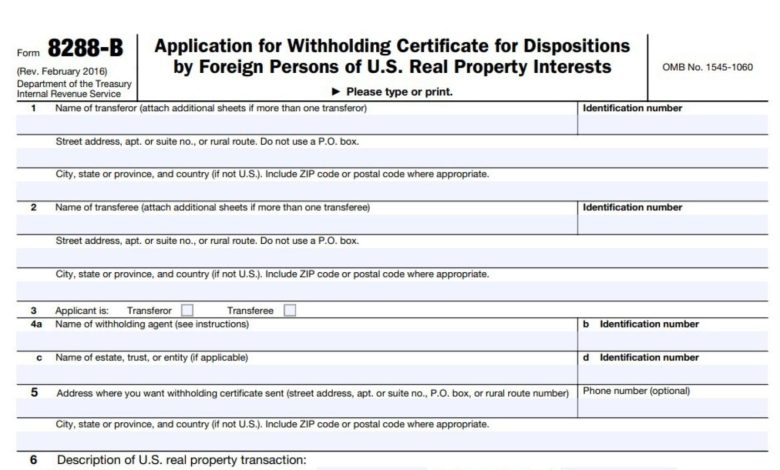
Form 8288-B, formally known as the “Application for Withholding Certificate for Dispositions by Foreign Persons of U.S. Real Property Interests,” is a powerful tool for foreign sellers of U.S. real estate who want to reduce the withholding tax applied to their sale. This IRS form allows sellers to demonstrate to the IRS their actual tax liability, which may be less than the default 15% withholding required under FIRPTA. By understanding who files form 8288-B, its purpose, and potential benefits, foreign sellers can effectively manage their tax obligations and ensure a smoother transaction.
Decoding FIRPTA and the Role of Withholding
The Foreign Investment in Real Property Tax Act (FIRPTA), enacted in 1980, is a cornerstone of U.S. tax law governing real estate transactions involving foreign entities. Its primary objective is to ensure that foreign individuals and corporations pay taxes on capital gains realized from selling U.S. real property interests. FIRPTA achieves this by requiring the buyer, or their designated withholding agent, to withhold a portion of the sale proceeds and remit it directly to the IRS. This withholding acts as a safeguard, guaranteeing that the IRS receives its due taxes from the transaction.
Withholding Responsibility: The Buyer’s Role
The onus of withholding and remitting taxes under FIRPTA falls squarely on the buyer’s shoulders. This responsibility extends to various scenarios, including:
- Direct Purchases: When a buyer acquires property directly from a foreign seller.
- Transactions Involving Withholding Agents: When a designated third-party, such as a title company, facilitates the transaction and manages the tax compliance aspects.
- Partnership Interests: In cases where a partnership is involved and the transferee of a partnership interest fails to withhold the required amount.
Form 8288: Reporting the Withholding
The buyer, acting as the transferee, must file Form 8288, officially titled “U.S. Withholding Tax Return for Dispositions by Foreign Persons of U.S. Real Property Interests,” to report the transaction details and the amount withheld to the IRS. Along with Form 8288, the buyer is also required to prepare Form 8288-A, “Statement of Withholding on Dispositions by Foreign Persons,” attaching copies A and B to their Form 8288 submission. This process ensures transparency and provides the seller with the necessary documentation to claim credit for the withheld taxes on their U.S. tax return.

Form 8288-B: The Seller’s Avenue for Reduced Withholding
While FIRPTA mandates withholding, the default 15% rate may exceed the seller’s actual tax liability, especially if they incurred losses or qualify for deductions. To address this potential over-withholding, FIRPTA provides a mechanism for sellers to request a reduced withholding rate or even complete exemption through Form 8288-B.
The following parties are eligible to file Form 8288-B:
- The Seller (Transferor): The primary filer, aiming to adjust the withholding amount.
- The Seller’s Representative: An individual or entity authorized to act on the seller’s behalf.
- A Qualified Intermediary: A third-party, often a specialized firm like FIRPTA Canada, handling the transaction and ensuring tax compliance.
Grounds for Reduced Withholding: Justifying the Request
Sellers seeking a reduced withholding rate through Form 8288-B must provide compelling evidence to support their claim. Common justifications include:
- Tax Treaty Provisions: A tax treaty between the U.S. and the seller’s country of residence may stipulate a lower withholding rate or complete exemption.
- Lower Estimated Tax Liability: If the seller can demonstrate, through calculations and supporting documents, that their anticipated tax liability is less than the 15% withholding, the IRS may grant a reduction.
- Non-Recognition of Gain: Certain transactions, like a 1031 exchange, may qualify for non-recognition of gain, making withholding unnecessary. In these cases, the seller must notify the buyer and the IRS, adhering to specific procedures.
- Installment Sales: Specific rules for installment sales can also lead to reduced withholding. The seller must demonstrate their eligibility under the guidelines outlined in Section 7 of Revenue Procedure 2000-35.
Essential Documentation for Form 8288-B: Supporting the Claim
To increase the likelihood of approval, Form 8288-B submissions must include comprehensive documentation backing the request. This includes:
- Taxpayer Identification Number (TIN): This verifies the seller’s tax status and is crucial for IRS processing.
- Property Sale Details: Comprehensive information about the transaction, such as the purchase price, closing date, and property description, should be provided.
- Tax Filings and Supporting Documents: Evidence supporting the seller’s claim for reduced withholding, such as tax returns from previous years, depreciation schedules, and invoices for property improvements, may be required.
- Tax Treaty Provisions (if applicable): If the request is based on a tax treaty, the specific treaty provision and a clear explanation of its applicability should be included.

Filing Form 8288-B
The timing of Form 8288-B submission is critical to its effectiveness. Ideally, the form should be filed at least 45 days before the closing date to allow ample time for IRS processing and the issuance of a withholding certificate. However, it’s important to understand that the IRS may require additional information or clarification, potentially delaying the process. To expedite the review, sellers should ensure the form is accurately completed and accompanied by all necessary supporting documents.
The Escrow Process: Managing Funds When Withholding Certificates Are Pending
If the IRS has not issued a withholding certificate before the closing date, the buyer is still obligated to withhold the 15% but can place the funds in escrow. A qualified attorney typically acts as the withholding agent, managing the escrowed funds until the IRS makes a determination on the Form 8288-B application. If the application is approved, the funds are released to the seller. If denied, the funds are remitted to the IRS.
Consequences of Not Filing Form 8288-B: Potential Pitfalls for Sellers
Failure to file Form 8288-B or submitting an incomplete or inaccurate application can have adverse consequences for sellers. Without a withholding certificate, the buyer is legally obligated to withhold the full 15% of the sale proceeds, regardless of the seller’s actual tax liability. This can tie up substantial funds that the seller could have otherwise used for other purposes. Additionally, the IRS may impose penalties for incorrect or delayed withholding, further increasing the seller’s financial burden.
Navigating FIRPTA: The Importance of Expert Guidance
The complexities of FIRPTA and its associated forms can be daunting for both buyers and sellers. Seeking guidance from experienced professionals, such as international tax attorneys or specialized firms like FIRPTA Canada, is highly recommended. These experts can provide valuable insights, ensuring compliance with regulations, minimizing tax liabilities, and facilitating a smooth transaction.

FAQs
What is the purpose of Form 8288-B?
Form 8288-B allows foreign sellers of U.S. real estate to request a reduced withholding tax rate or a complete exemption from withholding.
Who should file Form 8288-B?
The foreign seller, their representative, or a qualified intermediary handling the transaction can file Form 8288-B.
When should Form 8288-B be filed?
Ideally, Form 8288-B should be filed at least 45 days before the closing date. It can also be filed within a specified timeframe after the transaction.
What happens if Form 8288-B is not filed?
If Form 8288-B is not filed, the buyer is required to withhold the full 15% of the sale price, as mandated by FIRPTA, potentially leading to unnecessary withholding for the seller.
Where can I find more information about Form 8288-B?
Detailed information and downloadable forms are available on the official IRS website. You can also consult with a qualified tax professional for personalized guidance.